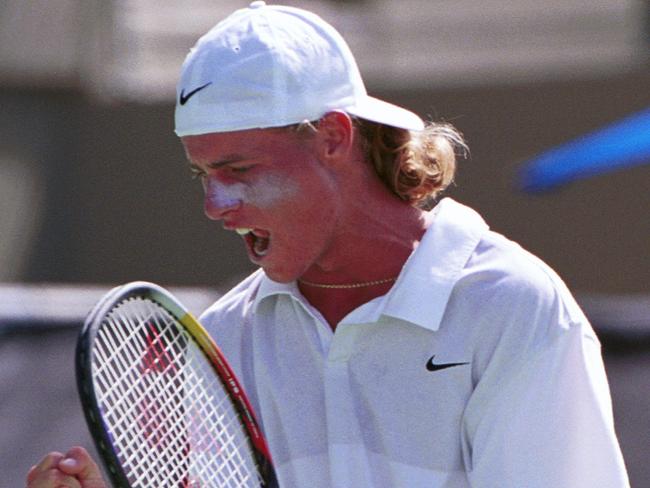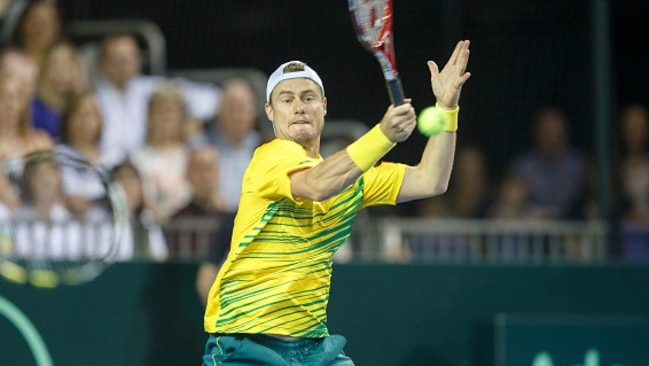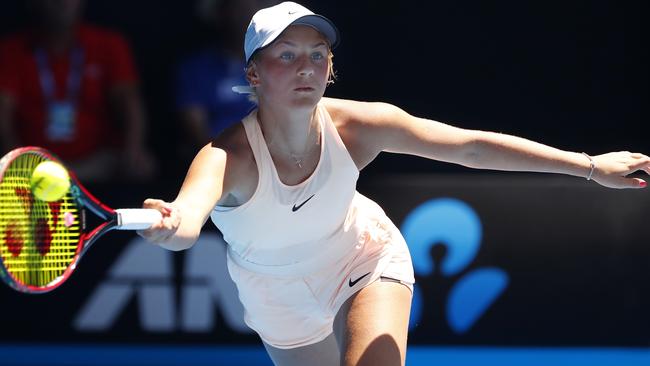Richard Evans investigates how tennis went from a sport for the young guns to an old man’s game
WITH age comes wisdom? Richard Evans discovers the key elements to player longevity in a time where Roger Federer and Rafael Nadal continue to thrive and being an older statesman is no longer seen as a handicap.

Tennis
Don't miss out on the headlines from Tennis. Followed categories will be added to My News.
IN professional sport, more than life even, the very mention of 30 something is to damn a player to imminent retirement or reflect that more days of glory lie behind than ahead.
Tennis has long been in the vanguard of such ageism, serial winners burning bright as teenagers — Boris Becker, Pete Sampras, Bjorn Borg — enjoying astounding if somewhat truncated careers.
The now, and oddly, somewhat forgotten Sampras kept going until 32 but the others fell earlier and were not alone. It’s what tennis players did then, it was a young man’s game.
HOT FORM: BEST SLAM RESULT BECKONS FOR BARTY
LEO SCHLINK: SUFFERING HARD, BUT RULES ARE RULES
DOUBLE BLOW: WHY NICK IS PULLING OUT OF THE DOUBLES
But the Australian Open 2018 tells a different tale. Look at the last 16 men this week, littered, if not with the infirm, but with the older. The reigning champion is 36, the world number one is 31, there’s not a teenager in sight with Nick Kyrgios, 23 in April, very much the new kid on the block.
So why?
”Eighty 80 per cent of players stop because of injury. But recovery methods have got better over time, players are more aware of the importance of looking after their bodies,” says Nathan Martin, long time fitness trainer to Lleyton Hewitt.

“Men are a lot more diligent with their recovery and preparation than women. The men’s game is so physical and men have to prepare to play five sets. You don’t see many guys ambling around the court. Men have to do a lot of off court conditioning, training and recovery, sports science has got a lot better and facilities at tournaments have improved.
“Novak really changed the game quite a bit with his yoga and breathing and diet. It takes a lot of discipline, Milos Raonic is the athlete most dedicated to looking after his body, he’s right into it.”
Breathing too is largely untouched within tennis he said, younger players take time to learn how to breathe properly, a massive energy source.
“It’s an important in-game relaxation tool. Slowing down your breathing helps with better decision making. Players look at the technical and physical side but not (these) mindsets.”
European players, in particular, have historically placed volume over variety when it came to training Martin said. Hitting lots of balls, and the wear and tear it brings, is now out, and more tailored routines are in. Players previously looking at calling it a day at 32 are now thinking, “I can get a couple more years out of this”.
Intriguingly, social media has improved player longevity. Thirty-five-year old Bruno Soares, Australian Open men’s doubles champion with Jamie Murray two years ago, is a fan.

“It’s made it easier and tougher, I’m able to see my son (via Skype) anytime I want, I call my wife, anytime I want,” he said.
“When I started travelling I was calling home once a week from a payphone, but the flip side is you lose matches and you get death threats on Twitter or Instagram so you have just to balance it for yourself, for me, it’s way more positive than negative.”
Tennis life is easier for men now he said, hence they hang around longer.
“Back in the day, people didn’t have access to the tools we have to for body recovery preparation. When I started, the physio was either for injury or sometimes after the match for something. Player recovery was very basic, I would just have a massage after a match. Today is a totally different ball game, cryotherapy, ice bath, it’s everything.”
Singles players now peak between 27 and mid 30s he said, which didn’t happen before as body fatigue kicked in. Learning to be patient will be a prerequisite for the new brigade he said.
“We have got amazing talent like Nick Kyrgios and Sascha Zverev, 20 years ago they would be contenders to win slams at 18. Nick can still win a grand slam right now but I think he would be way more prepared when he is 24, 25 or 26.”
Better prep has also led to greater competition through sheer numbers, players can hang around longer and will, though money is rarely a motivator at the high end says Martin.

“The older players want to start to contribute, to give something back, to help with the Davis Cup as with Lleyton. They want to leave a legacy.”
With age comes wisdom says Soares, players are a lot stronger mentally at 30 than 20.
“It’s very tough for an 18-year-old to know everything about himself, so meltdowns, breakdowns happen. Rafa was a different guy when he was 17 but at 31, I think he is better than before. There are old clips of Federer breaking racquets, everyone relates to his talent but people don’t realise how fit he is and how much mental strength he has. He never gives up in matches, you never see him cramping or exhausted.
“It’s something you only prove with experience. So many times for the first grand slam final you don’t know what’s going to happen, you get on court and you don’t feel your arm or your leg, it’s a totally different from being on court 17 at 11am. So you learn more about your body and your nerves and you get strong mentally.”
Topically, mental and physical resilience extends to playing in extreme conditions says Martin.
“Players should be able to play in the heat, these guys don’t play tennis in winter. They should be used to it, the US Open can get to 40 degrees. With the Australian Open being at the start of the year you can get someone coming from Russia and it’s 40 degrees, that’s a big change. Many players come from Europe, give them another month and they’ll deal with it.”

But spare a thought for the women. Soares is admirable in his analysis of the burden of touring.
“There are not many women playing as long. It’s difficult for them because eventually at 30, 31 they think about being a mum. Kim Clijsters gave up a couple of times to be a mum, it’s tough on them to make the decision because basically they have got to give up on their career so it is going to difficult to see more women playing longer.
“We just watched a 15-year-old girl on centre court (Marta Kostyuk), there’s so much pressure. How difficult it is to be a women out there travelling away from home, travelling alone. It’s scary for a 15 or 16 or 17-year-old.”


